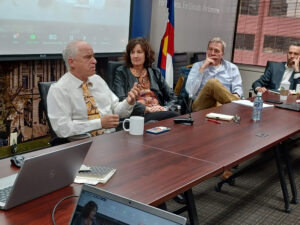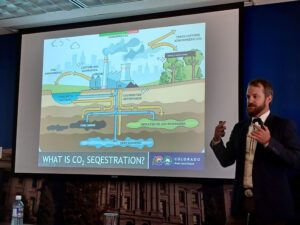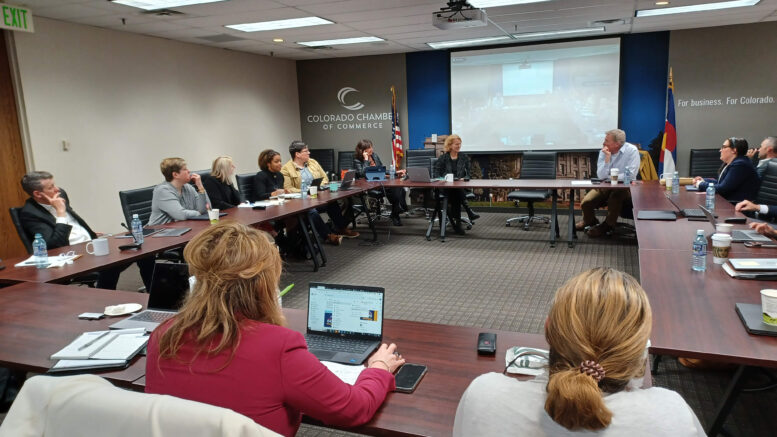Colorado must streamline permitting processes and make it easier for companies to develop the innovative energy solutions needed to meet the state’s ambitious emissions-reduction goals, according to a report Tuesday from a committee of business leaders who met for 10 months.
The Colorado Chamber of Commerce’s Environmental Sustainability & Climate Action Task Force developed the report as a road map for how industry leaders could work with the state to reduce greenhouse gases while also bolstering its energy economy. After five years in which industry often has been at odds with environmental legislative proposals, the task force’s goal was to ask state leaders to slow the rate of new regulations they are imposing and work in partnership with companies that also are trying to reduce their carbon footprints.
To do that, it laid out seven recommendations that members feel could boost air quality without adding prohibitively expensive regulations on companies that employ tens of thousands of workers and create an economic impact for the state measured in the tens of billions of dollars. The report comes after Gov. Jared Polis signed 55 pieces of legislation on climate, energy efficiency and electrification from 2019-22, Colorado Energy Office Executive Director Will Toor told the task force in March — and then signed more in 2023.

Colorado Energy Office Executive Director Will Toor speaks to the Environmental Sustainability & Climate Action Task Force.
Achieving a balance
“Climate change is a long-term business issue, and we’re committed to collaborating with environmental advocates and policy leaders to reduce emissions and work towards decarbonization,” Colorado Chamber President/CEO Loren Furman said.
“We also must recognize that new technologies require flexibility and a clear regulatory framework to fuel private sector innovation and investment,” Furman added. “There is path toward balancing a clean and healthy environment with a healthy economy, and this task force report lays out a plan to protect our environment without sacrificing growth, positioning Colorado as a leader in environmental policy solutions.”
The report comes just one day in advance of the 2024 Colorado legislative session, which begins on Wednesday and is likely to feature lengthy discussions about emissions reductions over the next 120 days. Members of an interim legislative committee on ozone pollution are likely to introduce bills that tighten regulations around air-quality permitting, while the Colorado Department of Public Health and Environment expects to push a bill that could give local governments more power to block polluting-increasing projects within their boundaries.
Continuing the discussions
The task force’s first recommendation — one that will go into action later this month — is to form an ongoing stakeholder group that will bring together industry and environmental leaders to discuss ways to reduce emissions that are both substantial and feasible. The Roundtable for Environmental Sustainability and Climate Urgency (RESCU) will help state leaders understand when carbon-cutting targets are unrealistic or could be sped up, and it can help agencies calculate the amount of greenhouse gas emissions that can be curbed with proposed rules.
Formation of the RESCU is a response to the common declaration, heard among both business leaders and some legislators, that state officials are “moving the goalposts” too often in creating new rules and speeding up timelines for achievement of a net-zero-emissions power grid. In 2023 alone, the Colorado Air Quality Control Commission passed new regulations on emissions within disproportionately impacted communities, from large manufacturers, from commercial buildings, from oil-and-gas operations and from gas-powered lawn equipment.

Loren Furman is president and CEO of the Colorado Chamber of Commerce.
The second recommendation is for the state to streamline the permitting system for emissions producers, which has been plagued by lengthy backlogs in permitting processes and can put up obstacles to innovative ways to produce lower-carbon energy. The task force asked the state to implement multiple changes, including requiring agency accountability to ensure timely and efficient permitting, encouraging permit writers to conduct site visits and supporting innovation in sustainability by providing less regimented permitting for decarbonization pilot projects.
“The existing permitting system for infrastructure and new technologies serves as a barrier to meeting the state’s emissions-reduction targets,” the report says. “Reforming the permitting system and investing in greater infrastructure planning will help facilitate Colorado becoming a leader in innovative technologies that can improve the environment. Taking such action also will help to attract the investments needed to develop new technologies in energy production and carbon removal.”
Carbon capture as an environmental tool
A key example of how that could work comes in the third recommendation from the task force. Colorado must provide both a clear regulatory structure and incentives for new carbon-cutting technologies that include direct air capture, manufacturing of hydrogen energy and carbon capture and storage, it states.
Carbon capture is a technology that extracts emissions — either from smokestacks at emissions-producing facilities or by pulling it directly from the air. Companies then can inject the carbon underground into depleted oil and gas reservoirs, deep aquifers or coal mines, both storing it safely outside the atmosphere and helping energy companies through the process to extract less carbon-intensive oil and gas.
Several environmental groups have criticized the process, saying that the state should not support any practice that continues to take natural resources from the ground. While the Legislature allowed the state to seek primacy on Class VI injection wells — a designation that would let it take over regulatory authority from the federal government and streamline efforts to increase carbon capture and storage — it failed to establish a regulatory framework it would need to permit the practice, and it set up several roadblocks to the procedure.
Other environmental strategies

Ben Teschner, solid minerals manager for the Colorado State Land Board, discusses a potential carbon sequestration project on state property with the Environmental Sustainability & Climate Action Task Force.
Task-force members said they want to work with state officials this year to pass enabling legislation that will advance this and other new technologies safely and efficiently. Ben Teschner — solid minerals manager for the Colorado State Land Board, which has leased land in Washington County to Carbon America to drill an exploratory well to determine if the earth below it can store liquefied carbon — noted that other states like Wyoming and North Dakota have achieved primacy and advanced in the regulatory process.
Other recommendations from the task force include:
- State agencies must account in emissions rulemaking for the concept of leakage — the idea that if Colorado makes it too hard for energy companies to operate here, they will do so in other states and produce emissions that still will impact this state;
- State officials must offer more incentives to commercial building owners to make the emissions-reducing upgrades being demanded by CDPHE;
- Colorado leaders should explore partnerships with nearby states in creating a regional carbon market that can facilitate reduction of emissions in hard-to-decarbonize sectors; and,
- Officials who are in the process of improving workforce-development strategies should focus efforts on creating pipelines of workers for renewable-energy and energy-transition sectors.
Task-force members included representatives from oil-and-gas firms, utilities, manufacturers, agricultural groups, mining companies, waste-management firms and more.
